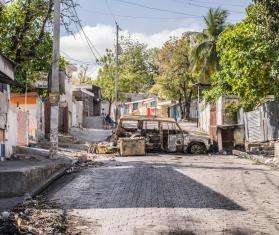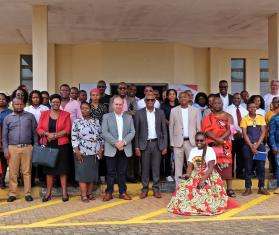MSF teams have been providing medical services day and night at different locations in Vavuniya district, including the hospital in Vavuniya city and at the checkpoint in Omanthai, close to the former frontline.
Some 77,000 people emerged from the former conflict zone in northern Sri Lanka and arrived in Vavuniya district in the five days following the end of the 26-year civil war between the Sri Lankan military and the Liberation Tigers of Tamil Eelam (LTTE) rebel group. Many of them needed urgent medical care. Doctors Without Borders/Médecins Sans Frontières (MSF) teams have been providing medical services day and night at different locations in the district, including the hospital in Vavuniya city and at the checkpoint in Omanthai, close to the former frontline.
Treating patients at the checkpoint
Roughly 10,000 people per day have passed through the Omanthai
checkpoint since the war ended on May 16 before arriving in Vavuniya. A four-person MSF team has been working there to identify the wounded and sick who need to be transferred to the hospital, to stabilize patients for transfer, and to provide as much on-the-spot medical care as possible.
On May 20, Dr. Jean-Paul Dixmeras, an MSF surgeon had just arrived to help the team in Omanthai when he found a 13-year-old girl with shrapnel embedded in her back. He instructed her not to move as he worked to extract it.
“We treat as many people as we can directly on site because the hospital
is more than full,” said Dr. Alexa ter Horst, a Dutch MSF doctor also working at the checkpoint. “It is always a difficult decision to make: treat on site or let them go to the camps, with the follow-up that can be provided there, or send them to the hospital, where there are already four patients to a bed.”
An average of 20 wounded people per day are referred to the hospital, while about 150 patients a day are treated by three MSF medical staff in the on-site clinic at Omanthai. “One of us goes through the long lines of people and sends to the clinic those who need the most medical care,” said Dr. ter Horst. “A large majority, among the last of the people that came out of the conflict zone, have wounds or scars from bullets and shelling. Many people had surgical procedures in the conflict zone. Some wounds are old and have healed, but others are bleeding—either because the wound is recent or because it has reopened. ”
Vavuniya hospital packed with patients
Patients are crowded into the emergency room in Vavuniya hospital, which makes moving around difficult. The hospital has 400 beds, but over 1,900
patients are presently packed into the hospital. MSF teams are supporting
Ministry of Health staff to help treat the sick and wounded.
“I’ve been doing around 30 surgical procedures per day over the last few
Days. Normally, I would do five,” said Dr. Matthew Deeter, one of four MSF surgeons working in Vavuniya hospital. “We sometimes work together on the same patient; one is amputating the leg and the other is amputating the arm. Or one is taking care of wounds in a foot and the others are treating chest wounds. The majority of the injuries are relatively mild, but we see lots of them on the same patients—something like 20 mild injuries for one person, caused by a bomb blast.”
Other MSF activities
The immediate priority for MSF is to treat the sick and wounded coming out
of the former war zone. In addition to providing support to Vavuniya
hospital, teams have set up post–operative care at the nearby Pompaimadhu
Ayurvedic Hospital to help with follow-up of patients. MSF has also
just set up a 100-bed field hospital with surgical capacity outside Manik
Farm, to the north of Vavuniya city, to provide emergency care to patients from surrounding IDP camps which hold approximately 160,000 people.




